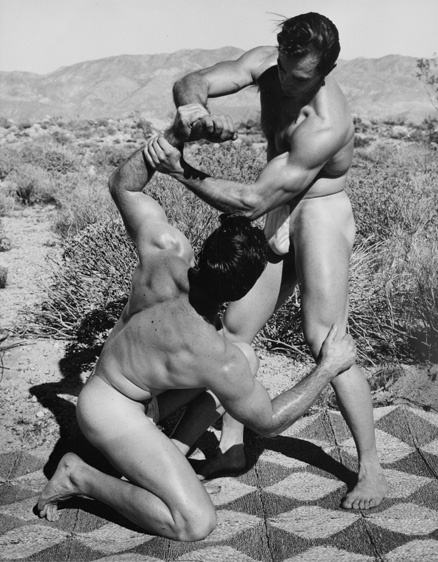
Bruce of L.A. (1900-1974), “Men Wrestling Outdoors,” undated. Gelatin silver print. Courtesy Kinsey Institute Gallery.
On a recent trip to New York I bored everyone with my constant comparisons to Berlin:
“In Berlin we do this…”
“New Yorkers have this kind of energy and Berliners have that kind of energy.”
“Berliners eat this, New Yorkers eat that.”
“You pay that much in rent? I pay this much.” [understandable moment of quiet resentment]
But it’s not only me who has this pathological need to measure the two metropolises. It seems like every other day I overhear a visitor glibly declare, “Look at all this trash and these squats—Berlin is just like New York in the ’70s!” The trendier districts in Berlin earn hipster-derision and comparisons to Williamsburg, while the posher ones are misleadingly branded as Berlin’s Upper East Side.
Perhaps most striking for me on this visit to New York—and certainly the most relevant for this column—are the differences between the two cities as they pertain to queer life, approaches and performance. I won’t make any sweeping generalizations here, but I’d like to compare two performances that I think are instructive about the pitfalls and successes of queer performance in general.
While in New York, I visited Dixon Place for the much lauded show Otherwise: Queer Scholarship into Song. The readings and subsequent performances translated the language of queer theory, which can be obfuscating and dry (not for me of course, I love it I swear) into something playful and accessible. There was a Judith Butler-inspired retelling of “The Girl from Ipanema” in which the scene was deconstructed using Butler-speak. All the songs were quite catchy, and I find myself still occasionally still humming Kay Turner‘s version of Jose Muñoz’s book Cruising Utopia. (Turner organized the event.) One of my favorites was the absurdly funny inner dialogue performed by Dynasty Handbag, inspired by Ann Cvetkovich’s Depression: A Public Feeling. Dynasty Handbag‘s performance was a hilarious tale about spartan loneliness and utility from the point of view of a cloistered (wink) nun.
The success of Otherwise is that it deftly combined humor and teaching in ways that felt thoughtful and approachable rather than flippant or intentionally distant. It was measured, rehearsed, and considerate of its Dixon Place audience, which of course, since I’m stuck in dichotomy city, made me think of its bizarro Berlin twin—a queer performance event where I left feeling alienated and discouraged, unable even to stay for a performance by the inimitable Karen Black.
It was a queer three-day event, called Camp/Anti-Camp a Queer Guide to Everday Life, hosted last year at the theatre venue Hebbel Am Ufer 2 (HAU 2). I attended the final night, which began with a Bruce LaBruce video and ended with a gameshow style performance by Vaginal Davis, and late night musical offerings from Black among others. Despite the promising lineup, the performances were often obtuse and alienating, meant to challenge traditional gender norms, but with few concessions and limited accessibility for the viewer. Davis, a personal Berlin favorite, was the MC of a poorly improvised game show, with most contestants hardly sober and unprepared, speaking ambiguously about art world gossip while estranging their audience.
I thought about my HAU 2 experience through the deafening applause at Dixon Place, a space filled with community and sense of audience outreach, a smiling proletarian spirit that sought to simplify rather than confound. There’s a lesson there somewhere, one that could perhaps be included in Turner’s book Transgressive Tales: Queering the Grimms.



